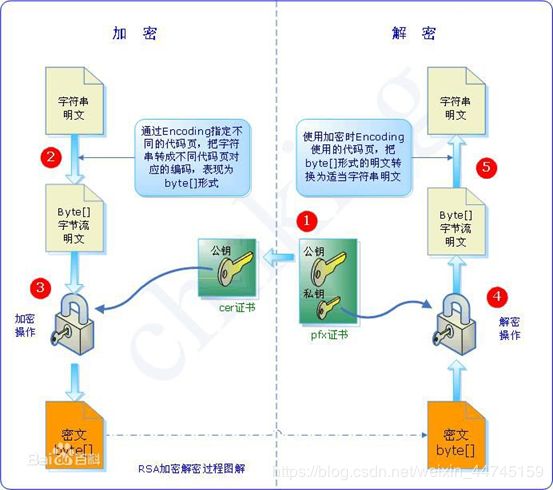RSA算法
RSA算法
RSA加密算法是一种非对称加密算法。在公开密钥加密和电子商业中RSA被广泛使用。
RSA原理:
RSA算法基于一个十分简单的数论事实:将两个大素数相乘十分容易,但是想要对其乘积进行因式分解却极其困难,因此可以将乘积公开作为加密密钥。通常是先生成一对RSA 密钥,其中之一是保密密钥,由用户保存;另一个为公开密钥,可对外公开,甚至可在网络服务器中注册。为提高保密强度,RSA密钥至少为500位长,一般推荐使用1024位。这就使加密的计算量很大。为减少计算量,在传送信息时,常采用传统加密方法与公开密钥加密方法相结合的方式,即信息采用改进的DES或IDEA密钥加密,然后使用RSA密钥加密对话密钥和信息摘要。对方收到信息后,用不同的密钥解密并可核对信息摘要。
对极大整数做因数分解的难度决定了RSA算法的可靠性。换言之,对一极大整数做因数分解愈困难,RSA算法愈可靠。假如有人找到一种快速因数分解的算法的话,那么用RSA加密的信息的可靠性就肯定会极度下降。但找到这样的算法的可能性是非常小的。
算法:
(1)选择两个不同的大素数p和q;
(2)计算乘积n=pq和Φ(n)=(p-1)(q-1);
(3)选择大于1小于Φ(n)的随机整数e,使得gcd(e,Φ(n))=1;注:gcd即最大公约数。
(4)计算d使得de=1mod Φ(n);注:即de mod Φ(n) =1。
(5)对每一个密钥k=(n,p,q,d,e),定义加密变换为Ek(x)=xe mod n,解密变换为Dk(x)=yd mod n,这里x,y∈Zn;
(6)p,q销毁,以{e,n}为公开密钥,{d,n}为私有密钥。
实例:
- 假设p = 3、q = 11(p,q都是素数即可。),则N = pq = 33;
- r =Φ(n)= (p-1)(q-1) = (3-1)(11-1) = 20;
- 根据gcd(e,Φ(n))=1,即gcd(e,20)=1,令e=3,则,d = 7。(两个数交换一下也可以。)
到这里,公钥和密钥已经确定。公钥为(N, e) = (33, 3),密钥为(N, d) = (33, 7)。
加密解密代码实现
package com.qian.encoded;
import org.apache.commons.codec.binary.Base64;
import javax.crypto.Cipher;
import java.security.KeyFactory;
import java.security.KeyPair;
import java.security.KeyPairGenerator;
import java.security.NoSuchAlgorithmException;
import java.security.SecureRandom;
import java.security.interfaces.RSAPrivateKey;
import java.security.interfaces.RSAPublicKey;
import java.security.spec.PKCS8EncodedKeySpec;
import java.security.spec.X509EncodedKeySpec;
import java.util.HashMap;
import java.util.Map;
public class RSAEncrypt {
private static Map keyMap = new HashMap(); //用于封装随机产生的公钥与私钥
public static void main(String[] args) throws Exception {
//生成公钥和私钥
genKeyPair();
//加密字符串
String message = "df723820";
System.out.println("随机生成的公钥为:" + keyMap.get(0));
System.out.println("随机生成的私钥为:" + keyMap.get(1));
String messageEn = encrypt(message,keyMap.get(0));
System.out.println(message + "\t加密后的字符串为:" + messageEn);
String messageDe = decrypt(messageEn,keyMap.get(1));
System.out.println("还原后的字符串为:" + messageDe);
}
/**
* 随机生成密钥对
* @throws NoSuchAlgorithmException
*/
public static void genKeyPair() throws NoSuchAlgorithmException {
// KeyPairGenerator类用于生成公钥和私钥对,基于RSA算法生成对象
KeyPairGenerator keyPairGen = KeyPairGenerator.getInstance("RSA");
// 初始化密钥对生成器,密钥大小为96-1024位
keyPairGen.initialize(1024,new SecureRandom());
// 生成一个密钥对,保存在keyPair中
KeyPair keyPair = keyPairGen.generateKeyPair();
RSAPrivateKey privateKey = (RSAPrivateKey) keyPair.getPrivate(); // 得到私钥
RSAPublicKey publicKey = (RSAPublicKey) keyPair.getPublic(); // 得到公钥
String publicKeyString = new String(Base64.encodeBase64(publicKey.getEncoded()));
// 得到私钥字符串
String privateKeyString = new String(Base64.encodeBase64((privateKey.getEncoded())));
// 将公钥和私钥保存到Map
keyMap.put(0,publicKeyString); //0表示公钥
keyMap.put(1,privateKeyString); //1表示私钥
}
/**
* RSA公钥加密
*
* @param str
* 加密字符串
* @param publicKey
* 公钥
* @return 密文
* @throws Exception
* 加密过程中的异常信息
*/
public static String encrypt( String str, String publicKey ) throws Exception{
//base64编码的公钥
byte[] decoded = Base64.decodeBase64(publicKey);
RSAPublicKey pubKey = (RSAPublicKey) KeyFactory.getInstance("RSA").generatePublic(new X509EncodedKeySpec(decoded));
//RSA加密
Cipher cipher = Cipher.getInstance("RSA");
cipher.init(Cipher.ENCRYPT_MODE, pubKey);
String outStr = Base64.encodeBase64String(cipher.doFinal(str.getBytes("UTF-8")));
return outStr;
}
/**
* RSA私钥解密
*
* @param str
* 加密字符串
* @param privateKey
* 私钥
* @return 铭文
* @throws Exception
* 解密过程中的异常信息
*/
public static String decrypt(String str, String privateKey) throws Exception{
//64位解码加密后的字符串
byte[] inputByte = Base64.decodeBase64(str.getBytes("UTF-8"));
//base64编码的私钥
byte[] decoded = Base64.decodeBase64(privateKey);
RSAPrivateKey priKey = (RSAPrivateKey) KeyFactory.getInstance("RSA").generatePrivate(new PKCS8EncodedKeySpec(decoded));
//RSA解密
Cipher cipher = Cipher.getInstance("RSA");
cipher.init(Cipher.DECRYPT_MODE, priKey);
String outStr = new String(cipher.doFinal(inputByte));
return outStr;
}
}
RSA签名及其验证
A和B进行加密通信时,B首先要生成一对密钥。一个是公钥,给A,B自己持有私钥。A使用B的公钥加密要加密发送的内容,然后B在通过自己的私钥解密内容
假设A要想B发送消息,A会先计算出消息的消息摘要,然后使用自己的私钥加密这段摘要加密,最后将加密后的消息摘要和消息一起发送给B,被加密的消息摘要就是“签名”。
B收到消息后,也会使用和A相同的方法提取消息摘要,然后使用A的公钥解密A发送的来签名,并与自己计算出来的消息摘要进行比较。如果相同则说明消息是A发送给B的,同时,A也无法否认自己发送消息给B的事实。
其中,A用自己的私钥给消息摘要加密成为“签名”;B使用A的公钥解密签名文件的过程,就叫做“验签”。
签名及其验证算法实现
using System;
using System.Collections.Generic;
using System.ComponentModel;
using System.Data;
using System.Drawing;
using System.Linq;
using System.Text;
using System.Windows.Forms;
using System.Security.Cryptography;
using System.IO;
namespace SecTest
{
public partial class RSASV : Form
{
public string str1;
public string MFileNamestr1;
public static string ToHexString(byte[] bytes) // 0xae00cf => "AE00CF "
{
string hexString = string.Empty;
if (bytes != null)
{
StringBuilder strB = new StringBuilder();
for (int i = 0; i < bytes.Length; i++)
{
strB.Append(bytes[i].ToString("X2"));
}
hexString = strB.ToString();
}
return hexString;
}
public RSASV()
{
InitializeComponent();
}
private void button1_Click(object sender, EventArgs e)
{
var cspPas = new CspParameters();
cspPas.KeyContainerName = "rsa_key";
RSACryptoServiceProvider RSA1 = new RSACryptoServiceProvider(cspPas);
RSA1.PersistKeyInCsp = false;
RSA1.Clear();
RSACryptoServiceProvider RSA = new RSACryptoServiceProvider(cspPas);
string str_Public_Key;
string str_Private_Key;
str_Public_Key = "";
str_Private_Key = "";
str_Public_Key = Convert.ToBase64String(RSA.ExportCspBlob(false));
str_Private_Key = Convert.ToBase64String(RSA.ExportCspBlob(true));
textBox1.Text = str_Public_Key;
textBox2.Text = str_Private_Key;
FileStream fs1 = new FileStream("C:\\RsaKey1.dat", FileMode.Create, FileAccess.Write);
string key = RSA.ToXmlString(false);
fs1.Write(Encoding.UTF8.GetBytes(key), 0, key.Length);
fs1.Close();
fs1.Dispose();
}
private void button2_Click(object sender, EventArgs e)
{
var cspPas = new CspParameters();
cspPas.KeyContainerName = "rsa_key";
RSACryptoServiceProvider RSA1 = new RSACryptoServiceProvider(cspPas);
string str_Public_Key;
string str_Private_Key;
str_Public_Key = "";
str_Private_Key = "";
str_Public_Key = Convert.ToBase64String(RSA1.ExportCspBlob(false));
str_Private_Key = Convert.ToBase64String(RSA1.ExportCspBlob(true));
textBox1.Text = str_Public_Key;
textBox2.Text = str_Private_Key;
}
private void button3_Click(object sender, EventArgs e)
{
var cspPas = new CspParameters();
cspPas.KeyContainerName = "rsa_key";
RSACryptoServiceProvider RSA1 = new RSACryptoServiceProvider(cspPas);
SHA1 sh = new SHA1CryptoServiceProvider();
if (textBox3.Text == "")
return;
FileStream fin = new FileStream(textBox3.Text, FileMode.Open, FileAccess.Read);
byte[] Data = new byte[fin.Length];
try
{
fin.Read(Data, 0, Data.Length);
fin.Seek(0, SeekOrigin.Begin);
}
catch
{
}
finally
{
if (fin != null)
fin.Close();
}
byte[] signData = RSA1.SignData(Data, sh);
textBox4.Text =Convert.ToBase64String(signData);
}
private void button4_Click(object sender, EventArgs e)
{
OpenFileDialog openFileDialog = new OpenFileDialog();
if (openFileDialog.ShowDialog() == DialogResult.OK)
{
textBox3.Text = openFileDialog.FileName;
MFileNamestr1 = textBox3.Text;
}
}
private void button5_Click(object sender, EventArgs e)
{
bool result;
FileStream fin = new FileStream(textBox3.Text, FileMode.Open, FileAccess.Read);
byte[] Data = new byte[fin.Length];
try
{
fin.Read(Data, 0, Data.Length);
fin.Seek(0, SeekOrigin.Begin);
}
catch
{
}
finally
{
if (fin != null)
fin.Close();
}
FileStream fkeyin = new FileStream("C:\\RsaKey1.dat", FileMode.Open, FileAccess.Read);
long keyL=fkeyin.Length;
byte[] key_buf = new byte[keyL];
fkeyin.Read(key_buf, 0, (int)keyL);
string strPublicKey;
strPublicKey = System.Text.Encoding.Default.GetString(key_buf);
RSACryptoServiceProvider RSA1 = new RSACryptoServiceProvider();
RSA1.FromXmlString(strPublicKey);
byte[] data = Convert.FromBase64String(textBox4.Text);
SHA1 sh = new SHA1CryptoServiceProvider();
result = RSA1.VerifyData(Data, sh, data);
if (result)
textBox5.Text = "验证通过。";
else
textBox5.Text = "验证失败。";
}
}
}
